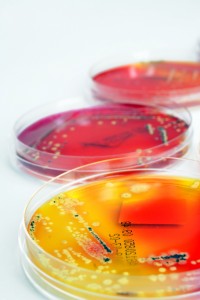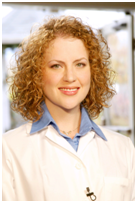Essential Oil Research and the Future
 by Nicole Stevens, MSc
by Nicole Stevens, MSc
Mankind discovered long ago that plants are very beneficial when it comes to medicinal compounds, and so essential oils have been used in health and healing for centuries for many reasons, mainly, they work.
Since a stationary plant can’t exactly run to escape attacking predators and can’t fight them off with long claws or sharp teeth, they have evolved to protect themselves in other ways. Plants prepare some amazing concoctions of chemicals that serve as protection against microbes and pathogens. These chemical cocktails also help the plant regulate its internal processes of growth, development, reproduction, and metabolism.
So why can’t these chemicals provide the same benefits in the human body? Actually they can. Plants and people evolve in the same habitats. We all face pathogens, we all strive to grow and thrive in our development and we all face eventual aging.
Science is just the beginning to delve into the mechanisms by which essential oils and other natural products function. Although we don’t have all the answers yet, it’s becoming increasingly clear that there is great power and potential in essential oils. Researchers have found antibiotic, anti-viral, anti-fungal, anti-inflammatory and anti-cancer properties in various essential oils. They’ve found compounds that can aid in DNA repair, increase metabolism, improve blood flow, balance hormone levels, improve waste elimination, stabilize neurotransmitters, and relax muscles and lower stress.
A mammoth of information is being generated about how essential oils work. Hopefully, as scientists continue to study natural products and how they can best be used; our Western medicine models will embrace a more holistic approach to healing. We may find that drugs from a test tube aren’t the only way (or sometimes the best way) to treat our ailments.
A Fledgling Essential Oil Researcher
My own experience researching essential oil began when I was a graduate student at Brigham Young University. My original research project fell through, but luckily for me, my adviser had a box full of essential oils and an idea to screen them against various cancer cells, I was intrigued.
I think what first drew me into the project was the idea of doing some kind of life-saving cancer research. This terrible disease, in which a body’s own cells turn rogue and grow out of control, seems to be a scourge against which we have so few reliable cures. Like most people in this country, my life has been touched by cancer. My maternal grandfather has fought skin cancer for the past few decades and I lost a great-aunt to ovarian cancer. Being the naïve and starry-eyed college student, I wanted to join the noble fight against cancer.
But I was also fascinated by the essential oil. At that point, I had no idea that these little amber bottles full of what I thought was basically perfume would prove to be so powerful.
I screened 70 essential oils against 5 different cancer cell lines. The procedure was fairly simple: I grew the cancer cells in Petri dishes until they were flourished, and then treated them with various concentrations of each oil. All tests were done in triplicate and repeated several times to make sure the results were consistent. Treatment Petri dishes containing essential oils were compared with untreated control dishes in which the cancer cells continued to grow as usual.
The results were astounding. Some essential oils were lethal against at least one cancer cell type, some oils killed multiple cancer cell types, and many of the oils were at least slightly inhibitory of cancer cell growth. But even more importantly—the essential oils showed little toxicity against non-cancer cells.
With these exciting preliminary results in hand, my taste for essential oil research grew insatiable. I wanted to test the oils against more cancer cells. I wanted to see just how powerful these oils were at increasingly low concentrations. I wanted to test them in living models to see if we could shrink tumors or stop lymphoma. I wanted to clone myself so I could do a thousand essential oil research projects simultaneously!
Let There Be Light
Life moves on and so did I. After graduation, before I could investigate more deeply into my original essential oil research project, my husband and I uprooted. I ended up at the University of Nevada, Las Vegas. But the move was a good one—I was able to get more involved in essential oil research with cancer cells. This time, there was a twist.
I learned of an emerging cancer treatment called photodynamic therapy (PDT). In this model, a patient is given a photosensitizing drug and then blasted with a specific wavelength of light. The idea is that the cancer cells, which are usually growing at a faster rate, will take up the photosensitizing drug more quickly than normal cells. Therefore, the light will kill cancer cells preferentially.
One of the biggest drawbacks of PDT is that the photosensitizing drugs can be highly toxic and cause damage to the kidneys, liver, and other body systems. Well, I thought, what if we used essential oil as a photosensitizing agent? Certain oils can increase photosensitivity when applied topically. Maybe we can cash in on that property to kill cancer cells but avoidtoxicity of the traditional PDT drugs.
My preliminary results were very encouraging. Once again, I didn’t have time to explore as deeply as I’d hoped into my project. But I found that breast cancer cells could be treated with essential oils, exposed to short bursts of specific wavelengths of light, and we’d see dramatic death rates. Once again, this effect appeared to be focused on cancer cells rather than non-cancer cells.
Thank You, Ladies and Germs
Another move found me at the University of Utah. My boss was a remarkable researcher in her own right, and she was enthusiastic when I approached her about a new research project with essential oils. This time, I’d take a peek at the antimicrobial properties of some oils that have traditionally been used for cleansing and healing.
I worked late into the night, running tests on Salmonella and Klebsiella pneumonia and Escherichia coli and Staphylococcus aureus. My boss would joke with me that she could always tell when I’d set up an experiment – the lab smelled like an aromatherapy spa.
The results were impressive. Honestly, I’d come to expect astounding scientific performance from these essential oils! I found that at least one essential oil could wipe out even the nasty bugs like a staph infection and most of the microbes were susceptible to multiple essential oils.
Thyme, basil, oregano and cinnamon are powerhouses in the battle against microbes. Oregano is effective at killing a huge percentage of microbes even when it’s diluted to a concentration of only 1:5000.
The Work Must Go On
Every day there are more papers published about the amazing health benefits and disease-fighting properties of essential oils. This website will serve as a forum in which exciting essential oil research is presented and discussed, hopefully in ways that make the science more palatable and useful to everyone.
I hope to someday continue my own research with essential oils. Each of my projects has served to cement two facts in my mind. First, that high-quality essential oils are a powerful tool for promoting health and fighting disease. And second, that science has only begun to understand the potential of these plant chemicals.
Essential oils are slowly making their way into mainstream use. More doctors and practitioners are educating themselves about the benefits of holistic healthcare. The ranks of researchers who study essential oils and other natural products are making astounding discoveries. Ironically, the ancient secrets of traditional medicine are once again becoming the cutting edge of modern medicine.
It’s about time.
 Nicole Stevens is an essential oil enthusiast with a professional desire to increase the credibility and the scientific understanding behind natural products. She has been researching the various properties of essential oils for much of her career.
Nicole Stevens is an essential oil enthusiast with a professional desire to increase the credibility and the scientific understanding behind natural products. She has been researching the various properties of essential oils for much of her career.
Nicole earned her undergraduate and Master’s degrees at Brigham Young University. Her Master’s Thesis was entitled “Bioassays to Determine Anti-Cancer Activity of Essential Oils.” For that project, nearly seventy essential oils and oil blends were tested against five different types of cancer in vitro.
In 2003, Nicole began working at the UNLV Cancer Research Center and completed a project looking at the possibility of using essential oils in a process called photodynamic therapy. This is a procedure that uses targeted photosensitizing chemicals and specific wavelengths of light to destroy cancer cells.
From 2009 – 2010, Nicole worked at the University of Utah. There, she completed a study analyzing the effectiveness of dōTERRA® essential oils against various microbial pathogens including Staphylococcus aureus, Escherichia coli and Klebsiella pneumonia.

No comments:
Post a Comment